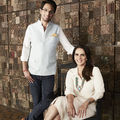Technology to check acoustic levels of textile fabrics
Using the new test methods, the experts can determine the suitability of a tent material or interior vehicle lining in protecting against sound waves, for example. On one hand, this is important with regard to protection against eavesdropping from modern directional microphones.
On the other hand, the concentration of sound levels is reduced by between 20 and 30 % at levels above 40 decibels (approximately the level of a radio at normal room volume). Therefore, passive noise protection is absolutely essential in order to prevent (as far as possible) carelessness by troops and supply units as a result of noise.
However, the noise created by equipment must also be controlled and minimised depending on their areas of use. Active noise protection prevents soldiers from being detected prematurely by electronic monitoring systems or enemy soldiers as a result of crackling or rustling combat dress or grinding boots when nearing their intended target. The “acoustic camouflage” of combat dress is therefore an important addition to the classical camouflage print.
When measuring sound absorption and transmission, the materials are clamped in a sample holder between a loudspeaker and highly sensitive measuring microphone so that they can be optimised accordingly.
The extent (in decibels) that the material reduces or absorbs the acoustic signal is measured in a frequency spectrum between 200 and 20,000 Hz. A key advantage here is the small sample size – even sizes of 10 x 10 cm are sufficient for testing. Samples with very different material thicknesses can also be inspected.
In active noise measurement, the textiles are automatically moved or crumpled together and the noises which occur within the audible frequency range are determined. In order to be able to simulate practical walking movements on fitted garments, boots or complete clothing systems, the mobile mannequin “Charlie” or a special boot model are used in some inspections. The noises generated by the mechanical testing equipment are measured in advanced and excluded from the final results.
The aeroacoustic test determines the frequency spectra of the often disturbing background noise of air flow in textiles. The Hohenstein Institute test apparatus is able to investigate virtually all samples ranging from small laboratory samples up to complete components and can simulate wind speeds of up to 140 km/h. The noises that occur are analysed using a computer program in order to determine their frequency range. These resulting comparative figures then enable materials to be optimised for the most diverse of uses.
As well as capturing the global acoustic properties of textile fabrics, the locally triggered causes of disruptive noises can also be determined. This knowledge can then be used to optimise textiles and components even more.
Hohenstein Institute
































-Ltd..jpg?tr=w-120,h-60,c-at_max,cm-pad_resize,bg-ffffff)





.jpg?tr=w-120,h-60,c-at_max,cm-pad_resize,bg-ffffff)
.jpg?tr=w-120,h-60,c-at_max,cm-pad_resize,bg-ffffff)






